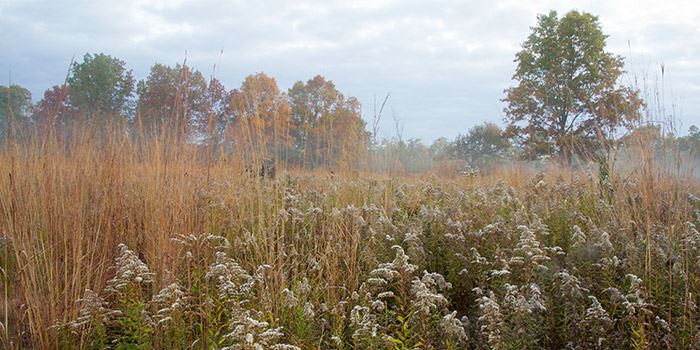The Oak Openings Then And Now

The sandy region of western Lucas County known as the Oak Openings looks very different today than it did in the 1800s. Much of Metroparks land management work is focused on preserving what's unique about this rare and special region that is home to more rare and endangered species than anywhere else in Ohio.
Habitats in Transition at Oak Openings Preserve Metropark
A Brief Look at Two Hundred Years of History
The Oak Openings Then And Now
Picture the landscape in the early 1800s: Sand heaped into dunes, with spreading oak trees interspersed with prairie grasses and flowers. Between the dunes were wetlands where water stood knee deep on top of rich, mucky soil. The early settlers dubbed this area the “Oak Openings” because the trees were spaced so far apart that they could drive a wagon through the woods in any direction. Oak Openings Preserve Metropark was named for this unique region in northwest Ohio – a region that harbored diverse landscapes of rare plants and animals.
Today, the Oak Openings Region is a mere shadow of itself. As a result of fragmentation due to farming and land development, the overall landscape has changed.
• Groundwater levels also decreased and fluctuated because of ditching and tiling practices
• Naturally occurring fire ceased, helping plant succession to overtake many of these areas.
• Trees crowded the now globally-imperiled oak savanna and sand dune environments
• Exotic plants invaded unique habitats
• Many of the special plants and animals that resided in the Oak Openings were becoming displaced as their unique landscape changed.
What Has Changed?
Big and small changes have continued to play a role in Oak Openings Preserve’s landscape.
1980s
Metroparks reintroduces fire as a management prescription in some overgrown areas. Controlled burning has become a common practice. Historically, fire was a natural process that periodically swept through the savannas and barrens in the Oak Openings Region. Fire girdles the trees and shrubs, yet favors the deep-rooted prairie grasses and oaks, which are specially adapted to fire. Fire encourages plant and animal biodiversity in these areas by maintaining much needed “openings between the oaks.”
2000
Metroparks received an “Oak Savanna 2000” grant to restore the plant and animal biodiversity that became buried or lost through the years in Oak Openings Preserve because of habitat changes. The oak savannas were once again enabled to support more biodiversity. As trees were being thinned, girdled and removed to allow more sunlight for rare plants to thrive in these areas, Oak Openings Preserve’s landscape was changing.
2002
Metroparks begins thinning the pines that were planted decades ago by the WPA, CCC and the park district. Pines are not native to northwest Ohio, and were planted either to harvest or to help stabilize the sand. The drought of 1988 years following placed stresses on the trees. Eventually, vast stands of pine monocultures throughout the preserve began to collapse after they became weakened from disease.
2003
The Emerald Ash Borer, an exotic beetle from Asia, attacked the ash trees of northwest Ohio. Since then, the preserve’s wetland landscape has taken on a new look. A large percentage of ash trees have fallen or have been removed, creating large forest canopy gaps resulting in invasive plants moving in. From 2010-2012, Metroparks, in conjunction with the U.S. Forest Service, received an “American Reinvestment and Recovery Act” grant to aid in the removal of ash trees and many acres of invasive plant species, as well as restoring those habitats with other native trees.
2010
The most recent change to the landscape of Oak Openings Preserve was a tornado that impacted 147 acres of the 3,765-acres preserve. The storm toppled and damaged thousands of trees. Metroparks land management plans for the storm-damaged areas include:
Control populations of woody and non-woody invasive plant species
Prior to cleanup, the storm damage prevented Metroparks staff from safely and effectively managing these areas to control invasive plant species. Undesirable species will now be removed to prevent them from threatening the ecological health of surrounding habitats.
Increase connectivity among globally rare savanna and prairie habitats
The storm damage lies close to globally significant savanna and prairie habitats that are currently managed by Metroparks staff to sustain their unique plant and animal diversity. Removing the storm damage will create natural corridors for wildlife, such as the endangered Karner blue butterfly, to move between these areas.
Reintroduce native prairie species to improve habitat for wildlife
Historically, the area damaged by the storm was made up of savanna and prairie habitats. Metroparks staff will actively restore this area by planting native prairie grasses and wildflowers on selected sites to improve habitat for wildlife species such as the Karner blue and another endangered species, the Lark sparrow.